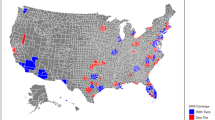Abstract
Beginning with a time-dependent definition of a house flip, the analysis examines flipping activity in Las Vegas from 1994 through mid-2007. We find that flip homes tend to be older and smaller than non-flip homes. Moreover, as the residential property market in Las Vegas begins to take off, flip homes become a more significant percentage of total sales. At the height of the housing boom in 2004, a typical flip produces an annual rate of return exceeding 60%. Even after adjusting for opportunity costs, this translates to economic profits of nearly 20%. However, shortly thereafter, the frenetic pace of the market begins to subside, and by 2007, economic returns to a flip fall to 0.









Similar content being viewed by others
Notes
Brunnermeier and Julliard (2008) largely side-step the use of the word bubble and instead refer to “implied mispricing” in the housing market. They develop an empirical proxy for the mispricing and show that it is significantly affected by changes in inflation.
An explanation of the repeat sales methodology appears in a Standard and Poor’s (2007) publication, while Labuszewski (2006) explains the CME’s real estate futures contract.
According to Case-Shiller, housing prices continued to fall in a dramatic fashion beyond the sample period. Between March 2007 and March 2008, Las Vegas house prices fell nearly 26%, the steepest decline of all major metropolitan areas in the U.S.
English (2005) points out that it is important to use tax record information as a significant number of flips are not registered on the Multiple Listing Service (MLS).
It is sometimes observed that the housing market is seasonal in nature and presents the possibility that flippers may want to buy during quiet periods (e.g., winter) and sell during dynamic periods (spring and summer). By estimating hedonic models on a quarter by quarter basis, we sidestep this issue by estimating price differences within a season. As a further note, however, we find that during our period of analysis, there is no significant difference in monthly sales volume. This may be, in part, a result of the explosive growth enjoyed by Las Vegas for much of our period of analysis.
Due to the significant number of parameter estimates for all the quarterly regressions, an exhaustive list is not provided in the paper. However, these estimates are available from the authors upon request.
The negative sign for the buy flip coefficient is persistent throughout the time period of analysis. Similarly, with the exception of 2007q2, the sell flip coefficients are always positive. Moreover, during the run-up period of 2003–2006, both sets of coefficients are statistically significant for every quarter.
In a related matter, we investigate whether the federal tax code influences the returns to flipping by examining sales that occurred 25–27 months after their purchase. Because primary residences are exempt from capital gains taxes (up to a $500,000 profit for a married couple) if lived in for at least two of the last 5 years, there exists the possibility that some owners delay their sale until just after the 2 year holding period. These “delayed flips” might be priced similar to sale flip prices if homeowners are trying to take advantage of a “hot market” and holding out for a buyer willing to pay a higher price. Conversely, sellers of delayed flips might share their tax break with the new owner resulting in a transaction below the sales flip price.
On a quarterly basis, we find that generally there is no statistical difference between the sell flip dummy variable and a dummy variable for delayed flips. However, we do find that delayed flips of 25–27 months as a percentage of all sales in the quarter increases from less than 1% in the 1990s to 4.1% in 2006q3. This suggests that as the Las Vegas market experienced a large run-up in prices, a growing number of homeowners were willing to put their home on the market to capture the significant appreciation of its value.
In essence, the nominal profits are what most individuals observe and make flips look so inviting as an investment opportunity. Nominal profits are also at the center of the popular television shows that suggest huge returns to the flipper. While television programs about flipping may subtract the costs of material and some labor, they typically do not adjust “profits” for the flipper’s time or for any transaction costs (e.g., realtor fees).
Annualized return, ra, equals (1 + rt)(1/t) – 1, where rt is the flip return over time period t.
References
Bertus, M., Hollans, H., & Swidler, S. (2008). Hedging house price risk with CME futures contracts: the case of Las Vegas residential real estate. Journal of Real Estate Finance and Economics, 37(3), 265–279. doi:10.1007/s11146-008-9129-z.
Brunnermeier, M. K., & Julliard, C. (2008). Money illusion and housing frenzies. Review of Financial Studies, 21(1), 135–180. doi:10.1093/rfs/hhm043.
Cohen, J. R. (2001). Abandoned housing: Exploring lessons from Baltimore. Housing Policy Debate, 12(3), 415–448.
English, W. (2005). The impact of property flipping on single family detached home prices. University of Texas at Arlington, December: Masters of Science in Real Estate Thesis.
Goodman, A. C. (1978). Hedonic prices, price indexes, and housing markets. Journal of Urban Economics, 5(4), 471–484. doi:10.1016/0094-1190(78)90004-9.
Goodman, A. C., & Thibodeau, T. G. (1995). Age-related heteroskedasticity in hedonic house price equations. Journal of Housing Research, 6(1), 25.
Goodman, A. C., & Thibodeau, T. G. (1997). Dwelling-age-related heteroskedasticity in hedonic house price equations: An extension. Journal of Housing Research, 8(2), 299–318.
Goodman, A. C., & Thibodeau, T. G. (1998). Housing market segmentation. Journal of Housing Economics, 7, 121–143. doi:10.1006/jhec.1998.0229.
Goodman, A., & Thibodeau, T. (2008). Where are the speculative bubbles in US housing markets? Journal of Housing Economics, 17(2), 117–137.
Granger, C. (1969). Investigating causal relations by econometric models and cross spectral methods. Econometrica, 37(3), 424–438. doi:10.2307/1912791.
Labuszewski, J. (2006). Introduction to CME housing futures and options. Chicago Mercantile Exchange Strategy Paper, 1–28.
Shiller, R. (2006). Long-term perspective on the current boom in home prices. The Economists’ Voice, 3(4), 4. Berkeley Electronic Press.
Rosen, S. (1974). Hedonic prices and implicit markets: Product differentiation in pure competition. Journal of Political Economy, 82(1), 34–55. doi:10.1086/260169.
Standard and Poor’s. (2007). S&P/Case-Shiller® home price indices: Index methodology, macromarkets.com/csi_housing/documents/tech_discussion.pdf.
Straszheim, M. (1974). Hedonic estimation of housing market prices: a further comment. Review of Economics and Statistics, 56(3), 404–406. doi:10.2307/1923985.
Wheaton, W., & Nechayev, G. (2008). The 1998–2005 housing “bubble” and the current “correction”: What’s different this time? Journal of Real Estate Research, 30(1), 1–26.
Acknowledgements
The authors would like to thank the journal’s special editors, Kanak Patel and Richard Buttimer, the conference host, Erasmo Giambona, and our discussant, Massimo Giuliodori, for their encouragement and valuable suggestions. We also appreciate the remarks of an anonymous reviewer who helped in the revision of this manuscript.
Author information
Authors and Affiliations
Corresponding author
Rights and permissions
About this article
Cite this article
Depken, C.A., Hollans, H. & Swidler, S. An Empirical Analysis of Residential Property Flipping. J Real Estate Finan Econ 39, 248–263 (2009). https://doi.org/10.1007/s11146-009-9181-3
Published:
Issue Date:
DOI: https://doi.org/10.1007/s11146-009-9181-3




